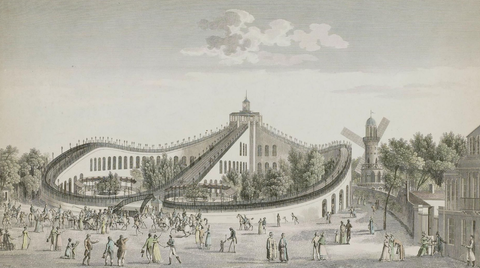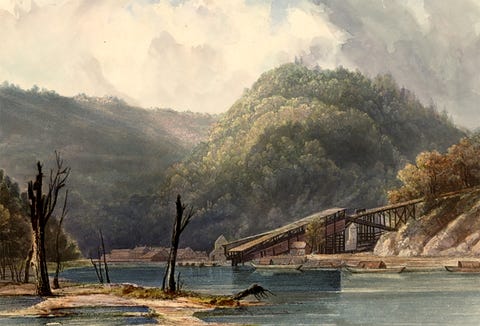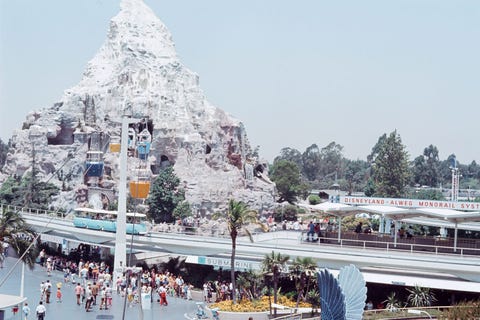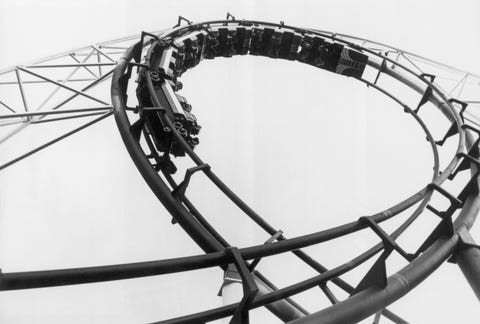From Russia to Disneyland: The 600-Year History of the Roller Coaster
They may be faster and taller, but the rules of physics still apply.
By Matt BlitzThe resounding click-clack muffles the murmur of anticipation as the train inches up the wooden structure. When the riders reach the apex, the bright blue summer sky swallows everything. Then, with a lurch, gravity takes over.
Everybody screams.
This is the legendary Giant Dipper roller coaster on the Santa Cruz Beach Boardwalk, located 75 miles south of San Francisco. Opened in 1924, it’s one of the world’s oldest roller coasters still in operation. Its maximum height of 75 feet pales in comparison to the behemoths that have been built in the century since. But the screams are no less deafening.
“You get to ride something your grandparents rode,” says Richard Munch, co-founder of the American Coaster Enthusiasts and historian for the soon-to-be-opened National Roller Coaster Museum in Plainview, Texas, “That’s so unusual in this day and age.”
“YOU GET TO RIDE SOMETHING YOUR GRANDPARENTS RODE.”
Today, the world's amusement parks are locked in a race of oneupmanship. Every new attraction must top what came before. Right now the world’s tallest roller coaster is in development, the world’s fastest hybrid coaster is in its maiden season, and the coaster with the most inversions in the country debuts next year.
Yet even the most technologically-advanced roller coasters aren’t much different from those rickety wooden coasters of the past.
“The basic core technology of a roller coaster is unchanged since the early 1900s,” says Robert Coker, author, theme park attraction designer, and co-host of the theme park podcast Season Pass. “Like a great composer, you have eight notes and a standard octave...but what you do with those notes is what makes it genesis."
FROZEN COASTER

Ice slides at a St. Petersburg carnival, 1800.
GETTY IMAGESFLORILEGIUS
The first roller coasters weren’t made of steel. They were made of ice.
Tracing their roots to 15th century Russia, these Middle Age thrill machines were giant wooden structures with frozen-over ramps. People slid down on ice blocks. Unsurprisingly, accidents were commonplace. “I was terrified out of my wits for fear... to go down for I had the... dread of breaking my neck,” reads one account.
Still, the slides were extremely popular. They became so fashionable with nobility that lighted torches were installed so people could slide well into the night.

A French proto-roller coaster at the Jardin Baujon in Paris, 1817.
WIKIMEDIA COMMONS
By the late 18th century, carriages with wheels were added to keep the thrills going in the warmer summer months, and by the early 19th century, the idea had emigrated across Europe. The French devised their own gravity-driven rides. These early coasters made one significant improvement by locking the cars’ wheels into the tracks via carved grooves, keeping the cars from derailing.
ROLL ME AWAY
In America, the roller coaster had more working-class origins. In 1827, industrialist Josiah White built a cheap, long, two paralleled track railway in Pennsylvania’s Lehigh Valley to haul the region’s precious coal. Primarily using only the natural landscape and gravity, the carts flew down the tracks at top speeds of about 50 miles per hour.

An illustration of Mauch Chunk railroad in 1839.
PRINCE MAXIMILIAN OF WIED
This simple system was a marvel that attracted many tourists eager to ride it. For decades, the Mauch Chunk Switchback Railway transported coal in the morning and carried tourists in the afternoon. By the 1870s, it became a full-time tourist attraction with thousands of thrill seekers a day riding the mile-and-a-half track.
The popularity of Mauch Chunk Switchback Railway inspired other similar attractions across the country in the 1870s and 80s. Patents include John G. Taylor’s Inclined Railway and Alanson Wood’s Circular Railway, which both depict entertaining variations of the switchback. It’s believed the phrase “roller coaster” came from Philo Stevens’s 1884 patent describing a “roller coasting” device built in Chicago.
Munch says there were also early coasters popping up in New Orleans, Philadelphia, St. Paul, and Tennessee. But what these early proto-coasters looked like—or even how they were designed—is mostly lost to history.
“We don’t know much about them,” says Munch, “There were no photos and the accounts that did exist had to do with accidents.”
THE GOLDEN AGE OF COASTERS
While traveling around selling his wares, it’s probable that women’s garment maker LaMarcus A. Thompson saw several of these coasters in action. Beyond being a salesman, he was an Indiana Sunday school teacher who was concerned with the prevalence of saloons and brothels and lack of wholesome family friendly entertainment. Thompson was also a burgeoning inventor who had previously created a seamless stocking machine.
In 1884, he designed and built a linear 600-foot two-tracked wooden framed ride with undulating railroad tracks and sideways seating similar to the one in Pennsylvania. He called it the Switchback Railway. One of the most important things about Thompson’s railway is where he decided to build it: New York’s Coney Island. This boardwalk on the tip of Brooklyn was the most popular amusement park in the country in the 1880s, and it was a well-known testing ground for innovation, including the escalator and, later, the baby incubator.
Flying along the track at a whopping speed of six miles per hour, the Switchback Railway was an immediate sensation thanks in large part to its location and Thompson’s marketing creativity.
“BIG THUNDER MOUNTAIN RAILWAY IS A CLASSIC SCENIC RAILWAY... AND SPACE MOUNTAIN. THEY ALL OWE THEIR GENESIS TO THE SCENIC RAILWAY."
“It was only about 50 feet tall,” says Tim Baldwin, editor of Rollercoaster! Magazine, “[but] it was very camel-like, going down up and down hills that got smaller and smaller. It definitely had a roller coaster feel to it.”
Competition soon forced Thompson to pursue even more daring designs. In 1887, he debuted the “Scenic Railway” in nearby Atlantic City. Essentially, it was a switchback railway but with “scenes,” which eventually included decorated walls, constructed facades, and groves of trees made to look like the Swiss Alps, Venetian Canals, the North Pole, or even the bottom of the ocean. At a time when world travel was out of reach for most, Thompson’s scenic railway brought the world to them.
“Any coaster that has a scene, all could be called... scenic railways,” Coker says. “Big Thunder Mountain railway is a classic scenic railway... and Space Mountain. They all owe their genesis to the Scenic Railway.”
Unlike the switchback, the Scenic Railway had an on-board brakeman, a continuous cable that pulled the train up the track, and a completed circuit so that attendants didn’t need to push the carriage onto a separate track. Thompson ended up constructing more than dozen scenic railways for parks across the country, including in Santa Cruz, Coney Island, and Minneapolis.

A scenic railway at the California Midwinter International Exposition in San Francisco, 1894.
SFSU
This preamble led directly to what’s called the “Golden Age of Roller Coasters,” beginning at the turn of the 20th century until the late 1920s. These two decades would see innovations like the figure 8 coaster, underfriction wheels, coasters that jumped, and, even the world’s first looping coaster (though, the looping coaster didn’t last long because the g-forces resulting from the circular loops caused neck pain).
By the end of the 1920s, it’s estimated that nearly 2,000 wooden roller coasters existed worldwide. “It was cheap entertainment. People needed a diversion,” says Baldwin, “They were thrilling and took them out of their everyday experience.” Today, there are a few Golden Age coasters remaining that one can still ride, including the Jack Rabbit in New York and the Wild One outside of D.C.
WHEN YOU WISH UPON A ROLLER COASTER...

Dilapidated roller coaster Thunderbolt at Coney Island. Built in 1925, the Thunderbolt survived the Great Depression but stopped operations in 1982 and was demolished in 2008.
GETTY IMAGESPHOTOSOUL
Like so many things in the late 1920s and early 1930s, roller coasters were nearly undone by the Great Depression.
The economic downtown meant people couldn't afford amusement park prices. Attendance dropped and owners stopped making improvements to their parks, leaving aging rides more susceptible to fire and rot. Then World War II drained labor and building materials, and with the ‘50s suburbia explosion, real estate values skyrocketed, making the land too valuable not to sell.
The amusement parks that remained were run-down hangouts for mischievous teens, loud drunks, and degenerate gamblers. In the early 1950s, it seemed that the roller coaster was destined for the scrap bin of history. And then Walt Disney happened.
Disneyland’s origin tale is now part of American lore. While taking his kids to the carousel in Griffith Park in Los Angeles, Disney dreamed of a place full of wonder and magic that the whole family could enjoy together. In 1955, Disneyland was born in a place that had been orange groves, and the story of the amusement park changed forever.
Only a few years later, Disney set off the modern age of roller coasters with the opening of the Matterhorn. Inspired by his frequent trips to the Swiss Alps and the live-action Disney movie “Third Man on the Mountain,” the ride is Disney’s homage to Thompson’s scenic railway, taking riders from sunny California to the snow-capped mountains. The Matterhorn Bobsleds' first day of operations on June 14, 1959, was such a big deal that Vice President Richard Nixon and his family showed up for the festivities.

Matterhorn in the 1970s.
GETTY IMAGESMIRRORPIX
Disney organized a pre-ride show of climbers summiting the 147-foot man-made mountain (exactly 1/10th the size of its namesake). Its track sliced in and out of the giant structure, wooing onlookers with a visual spectacle. When asked why the mountain had so many holes in it, Disney casually respond “because it’s a Swiss mountain.”
While the Matterhorn was a throwback to earlier scenic coasters, it was also a hugely important innovation. Disney collaborated with a small California-based machine shop operated by two World War II vets called Arrow Dynamics to build the Matterhorn, which was the first coaster to use multi-functional tubular steel rails which were highly resistant to corrosion and high temperatures. They were also more malleable, allowed for tighter twists and turns, and made for a smoother, more compact, and ultimately faster ride than wooden roller coasters.
“The Matterhorn started it all,” Munch says.

Cedar Point Corkscrew, 1976.
GETTY IMAGESBETTMANN
Tubular steel became the go-to material for the next era of roller coasters that quickly blossomed. There were intense scenic railways like 1966’s Runaway Mine Train at Six Flags Over Texas. Cedar Point’s Corkscrew opened in 1976 as the only coaster in world to turn people upside down three times. By the 1990s, riders were being inverted, flown while standing up, and launched zero to 54 miles an hour in seconds using magnetic fields.
In 2018, we are going higher and faster than ever before. From Abu Dhabi to New Jersey, engineers continue building the world’s longest, fastest, and tallest. But, ultimately, at their core, roller coasters aren’t much different than 15th century Russian ice slides, the Pennsylvania coal carts, switchback railways, and wooden up-and-downs of time’s past.
One of today’s most popular coaster construction companies, Idaho's Rocky Mountain Construction, now retrofits old, worn-down wooden coaster with a new, steel framework, giving new life to old roller coasters.
It's the past meeting the present.

Kingda Ka, the tallest roller coaster in the world.
No comments:
Post a Comment